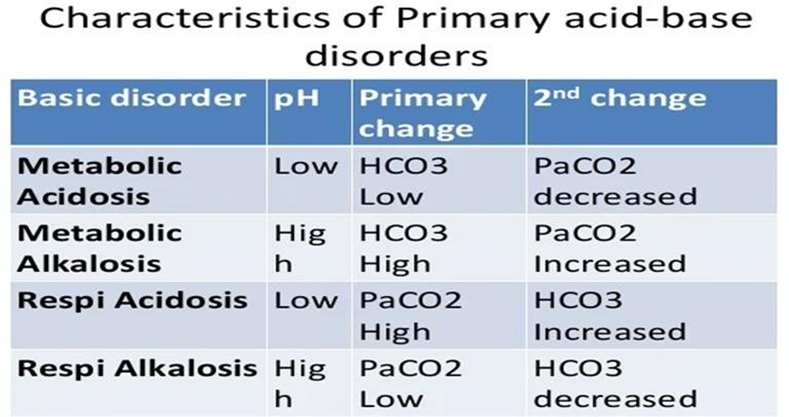A client is admitted with a suspected opioid overdose and a respiratory rate of 6 breaths per minute. Which of the following data would the nurse anticipate? (SELECT ALL THAT APPLY)
pH 7.29
Pa CO2 54
pH 7.51
PaO2 72
Pa CO2 31
Correct Answer : A,B
A. pH 7.29: A respiratory rate of 6 breaths per minute suggests hypoventilation, which can lead to respiratory acidosis due to retention of carbon dioxide (CO2). A decrease in pH (acidosis) is expected in this scenario.
B. PaCO2 54: In respiratory acidosis, PaCO2 levels are elevated due to inadequate ventilation, leading to CO2 retention. Therefore, an elevated PaCO2 level would be anticipated in this situation.
C. pH 7.51: A pH of 7.51 indicates alkalosis, which is not consistent with the expected respiratory acidosis in the context of opioid overdose and hypoventilation. Therefore, this choice is not anticipated.
D. PaO2 72: Oxygenation may be impaired in opioid overdose due to respiratory depression, but this PaO2 level is within the normal range. Hypoxemia is not typically a prominent feature of respiratory acidosis unless there are concurrent respiratory conditions or complications. Therefore, this choice is not anticipated.
E. PaCO2 31: A PaCO2 level of 31 indicates hypocapnia, which is not consistent with the expected respiratory acidosis in the context of opioid overdose and hypoventilation. Therefore, this choice is not anticipated.

Nursing Test Bank
Naxlex Comprehensive Predictor Exams
Related Questions
Correct Answer is D
Explanation
D. This response validates the client's feelings without making assumptions, allows the client to share more about their experience, and fosters a supportive environment. It's important for healthcare professionals to create a space where clients feel heard and understood, especially during times of grief and new diagnoses, which can be overwhelming.
A. It acknowledges the client's feelings while also expressing the nurse's understanding of the grieving process. It reassures the client that they are not alone in their experiences, even if the nurse hasn't experienced the exact situation. However, telling the client that you know what they are going through may not make them feel understood.
B. While this response acknowledges the client's grief, it may come across as minimizing or dismissive of their current emotional distress related to their diabetes diagnosis. It focuses solely on the loss of the spouse and doesn't address the client's immediate concerns about managing their newly diagnosed condition. Therefore, it may not be the most therapeutic response in this situation.
C. This response might unintentionally invalidate the client's feelings by suggesting they should distract themselves from their grief and diabetes diagnosis. It could be perceived as dismissive or insensitive, as it doesn't address the client's emotional needs or offer support. Additionally, suggesting distraction may not be helpful or appropriate for someone experiencing significant emotional distress.
Correct Answer is A
Explanation
A. One of the primary purposes of inserting an NG tube is to decompress the stomach by removing gastric contents. In the case of abdominal distention and severe vomiting, excess gas and fluid accumulation in the stomach can contribute to discomfort and further vomiting. The NG tube provides a way to suction out these contents, relieving pressure and reducing symptoms.
B. NG tubes can also be used to administer medications directly into the stomach. This route is particularly useful when a client is unable to take medications orally due to vomiting or other gastrointestinal issues. Medications can be crushed and dissolved in liquid form before being administered through the NG tube.
C. In some situations, such as when assessing for gastrointestinal bleeding or checking for tube placement, it may be necessary to determine the pH of gastric secretions. Gastric aspirate obtained through the NG tube can be tested for acidity, which can help confirm that the tube is correctly positioned in the stomach and provide information about the client's digestive function.
D. While NG tubes can be used to supply nutrients via tube feedings, this is not typically the primary rationale for their use in the acute situation described (abdominal distention and severe vomiting). However, in cases where a client is unable to tolerate oral intake due to their condition, tube feedings can be administered through the NG tube to provide essential nutrients and maintain nutritional status.
Whether you are a student looking to ace your exams or a practicing nurse seeking to enhance your expertise , our nursing education contents will empower you with the confidence and competence to make a difference in the lives of patients and become a respected leader in the healthcare field.
Visit Naxlex, invest in your future and unlock endless possibilities with our unparalleled nursing education contents today
Report Wrong Answer on the Current Question
Do you disagree with the answer? If yes, what is your expected answer? Explain.
Kindly be descriptive with the issue you are facing.
